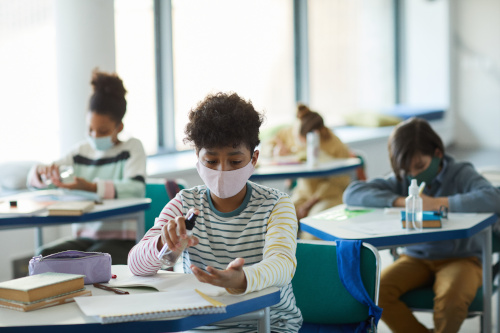Students have started a new school year and are facing the many challenges still present with in-person learning amid a pandemic. One of the most important to address is how schools address student safety and health–both physical and mental. CDC research has already documented the negative effects COVID-19 has inflicted upon children’s mental well-being.
Schools that established health and safety policies and procedures before this academic year began are best poised to help protect their students’ well-being. But it’s not too late–as school leaders confront the evolving situation, security technology can help build an environment where students feel safe, comfortable, and confident, and where every person’s well-being is prioritized.
Integrating security technology doesn’t have to be a complex process. Keep reading for an easy-to-follow approach school leaders can use to identify and execute on opportunities for enhancing their students’ health and safety journey.
Step 1: Review the school environment
As students return to classrooms and hallways, administrators can begin by studying how students interact with the building and its occupants. Ask questions about every part of the journey, such as:
- How many steps does a student take between the front door and their classroom?
- Do they pass through any high-traffic areas?
- How many doors do they touch?
- Where and how do they engage with others throughout the day?
These questions may reveal places to make adjustments or highlight old vulnerabilities to solve. If you deployed security technology last year, such as human temperature screening or a visitor management system, consider how that impacts your readiness this year. Another option is to note how students move through points of congregation, including:
- Shared restrooms
- Cafeterias during lunch
- Gymnasiums and playground equipment
- Guidance counselors’ and nurses’ offices
Step 2: Reassess health and safety policies and procedures
With a mapped safety journey of the building and how people interact within it, administrators can figure out how health and safety policies could influence those interactions. That may require policy changes familiar from last school year, such as:
- Staggering class start and end times.
- Placing students in cohorts and restricting interactions to particular groups.
- Redesigning the building’s people flow.
- Designating exit-only areas to reduce the number of people passing through the same door.
Even though many schools are already in session, the pandemic is reminding us of the need to adapt quickly to changing circumstances. It’s better to adjust policies now instead of never.
School administrators should also review how they’ll use processes to enforce new or revised policies — leaving students to follow new policies on their own will likely confuse them, potentially reducing their confidence and your system’s effectiveness. Last year, schools installing automated visitor management systems ran headlong into this issue. Because the administrators had never used this kind of technology before, they relied on cumbersome manual processes to assess visitors’ health before entering the building. They couldn’t use their system most effectively, which affected the confidence of the students they aimed to protect.
Step 3: Let processes drive security technology decisions
While processes reinforce policies, well-integrated security technologies can enhance processes. Given the school year is in progress, administrators may feel rushed to buy solutions. But without proper planning, technology may do more harm than good. Now’s the time to partner with a technology integrator that can guide administrators to the best solutions and integrate them effectively to better protect staff and students.
The Delta variant has made plain the importance of proper planning, and student safety and well-being depends on how schools enforce health and safety policies and procedures. Understanding their school’s safety journey and partnering with the right technology integrator, administrators can help create safe places to learn and help students feel confident as the school year progresses.
- High school students say AI will change the workforce - April 18, 2024
- Motivating students using the Self-Determination Theory - April 17, 2024
- Michigan Virtual’s statewide workgroup releasing AI guidance for K-12 educators - April 17, 2024


